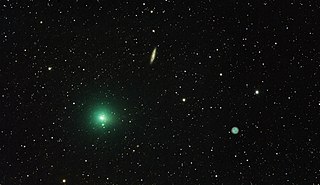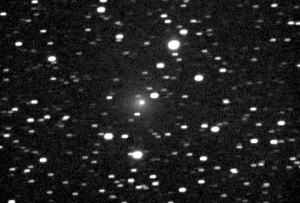Related Research Articles

12P/Pons–Brooks is a periodic comet with an orbital period of 71 years. It fits the classical definition of a Halley-type comet with an orbital period between 20 and 200 years, and is also one of the brightest known periodic comets, reaching an absolute visual magnitude ~5 in its approach to perihelion. Comet Pons-Brooks was discovered at Marseilles Observatory in July 1812 by Jean-Louis Pons, and then later recovered in 1883 by William Robert Brooks.
Comet 87P/Bus is a periodic comet with an orbital period of 6.5 years. It fits the definition of an Encke-type comet with. It was discovered by Schelte J. Bus in 1981 on a plate taken with the 1.2m UK Schmidt telescope at Siding Spring, Australia. The discovery was announced in IAU Circular 3578 on March 4, 1981.

41P/Tuttle–Giacobini–Kresák is a periodic comet in the Solar System. The comet nucleus is estimated to be 1.4 kilometers in diameter.

65P/Gunn is a periodic comet in the Solar System which has a current orbital period of 6.79 years. The comet is a short-period comet, orbiting the Sun every 6.79 years inside the main asteroid belt between the orbits of the planets Mars and Jupiter.

77P/Longmore is a periodic comet in the Solar System, with a period of 6.8 years.

7P/Pons–Winnecke is a periodic Jupiter-family comet with a six-year orbit. Early calculations for the 1921 apparition suggested that the orbit of the comet might collide with Earth in June, but observations on 10 April ruled out an impact. It made a very close approach to Earth in June 1927. The outward migration of perihelion created impressive meteor showers in 1916, 1921 and 1927.

Comet Finlay is a periodic comet with an orbital period of 6 years discovered by William Henry Finlay on September 26, 1886. The next perihelion passage is July 13, 2021 when the comet will have a solar elongation of 54 degrees at approximately apparent magnitude 10. It last came to perihelion on December 27, 2014, at around magnitude 10. Of the numbered periodic comets, the orbit of 15P/Finlay has one of the smallest minimum orbit intersection distances with the orbit of Earth (E-MOID). In October 2060 the comet will pass about 5 million km from Earth.
20D/Westphal was a periodic comet with an orbital period of 61 years. It fits the classical definition of a Halley-type comet. The comet appeared to disintergrate during the 1913 apparition and hasn't been observed since then.

Comet Schaumasse is a periodic comet discovered by Alexandre Schaumasse on 1 December 1911 as 12th magnitude. It next comes to perihelion on 8 January 2026 and should brighten to about magnitude 9.

54P/de Vico–Swift–NEAT is a periodic comet in the Solar System first discovered by Father Francesco de Vico on August 23, 1844. It has become a lost comet several times after its discovery. The comet makes many close approaches to Jupiter. The comet was last observed on 20 December 2009 by Ageo Observatory.
206P/Barnard–Boattini was the first comet to be discovered by photographic means. The American astronomer Edward Emerson Barnard did so on the night of October 13, 1892.

68P/Klemola or Klemola's Comet is a periodic comet, which belongs to Jupiter's comet family, that was discovered in 1965 by American astronomer Arnold Richard Klemola in Argentinian Yale-Columbia Southern Station. Its orbital period is 10.82 years.
82P/Gehrels is a periodic comet that was discovered on October 27, 1975, by Tom Gehrels at the Palomar Mountain Observatory in California having a faint nuclear brightness of magnitude 17.
C/2000 W1 (Utsunomiya–Jones) is a long-period comet from the Oort cloud discovered on November 18, 2000, by Syogo Utsunomiya and Albert F. A. L. Jones. The comet reached up to apparent magnitude 5.5, but was only 27 degrees from the Sun in mid-December 2000.

62P/Tsuchinshan, also known as Tsuchinshan 1, is a periodic comet discovered on 1965 January 1 at Purple Mountain Observatory, Nanking. It will next come to perihelion on 25 December 2023 at around apparent magnitude 8, and will be 0.53 AU (79 million km) from Earth and 110 degrees from the Sun.
51P/Harrington is a periodic comet in the Solar System.
79P/du Toit–Hartley or du Toit 2 is a periodic comet, now divided into two parts, in the Solar System with an orbital period of 5.06 years. It next comes to perihelion in September 2023 but is only expected to reach about apparent magnitude 18. It will be less than 90 degrees from the Sun from February 2023 until June 2024. On 26 May 2024 it will be 2.7 AU from the Sun and Earth.

Comet 252P/LINEAR is a periodic comet and near-Earth object discovered by the LINEAR survey on April 7, 2000. The comet is a Jupiter family comet, meaning that it passes quite close to the orbit of Jupiter.

104P/Kowal, also known as Kowal 2, is a periodic Jupiter-family comet discovered by Charles T. Kowal in 1979. The orbit was confirmed after new sightings in 1991 and 1998.

210P/Christensen is a Jupiter family periodic comet with an orbital period of 5.7 years. It was discovered by Eric J. Christensen on 26 May 2003 in images taken by the Catalina Sky Survey and recovered in images obtained by STEREO, the first time a single-apparition comet was recovered by a spacecraft.
References
- ↑ Syuichi Nakano (19 November 1999). "122P/de Vico (NK 724)". OAA Computing and Minor Planet Sections. Retrieved 2 February 2012.
- ↑ "Horizons Batch for 122P/de Vico (90001014) on 2069-Oct-14" (Perihelion occurs when rdot flips from negative to positive). JPL Horizons . Retrieved 21 June 2022. (JPL#27 Soln.date: 2001-Jul-02)
- ↑ "122P/de Vico Orbit". Minor Planet Center . Retrieved 17 June 2014.
- ↑ Seiichi Yoshida (9 November 2005). "122P/de Vico". Seiichi Yoshida's Comet Catalog. Retrieved 20 February 2012.
- 1 2 "JPL Small-Body Database Browser: 122P/de Vico" (25 June 1996 (last obs) // Soln.date: 2001-Jul-02). Jet Propulsion Laboratory . Retrieved 26 July 2012.
- 1 2 3 Kronk, Gary. "122P/de Vico". cometography.com. Retrieved 13 March 2023.
- ↑ Green, Daniel (15 September 1995). "IAUC 6228: 1995 S1; 6P". www.cbat.eps.harvard.edu. Retrieved 25 March 2023.
- ↑ Green, Daniel (29 September 1995). "IAUC 6239: 1995ad; GRO J2058+42; P/1995 S1". www.cbat.eps.harvard.edu.
- ↑ Green, Daniel (2 November 1995). "IAUC 6255: 1995al; N Aql 1995; 122P". www.cbat.eps.harvard.edu.
- ↑ Shanklin, J. D. (1 December 2000). "The comets of 1995". Journal of the British Astronomical Association. 110: 311. ISSN 0007-0297.
- ↑ Brandt, J.C.; Yi, Y.; Petersen, C.C.; Snow, M. (July 1997). "Comet de Vico (122P) and latitude variations of plasma phenomena". Planetary and Space Science. 45 (7): 813–819. doi:10.1016/S0032-0633(97)00049-4.
- ↑ Daniel Kirkwood (1886). "The Comets 1812 I, and 1846 IV". The Sidereal Messenger. 5: 13–14. Bibcode:1886SidM....5...13K.
- ↑ Hasegawa, I. (1 January 1979). "Orbits of Ancient and Medieval Comets". Publications of the Astronomical Society of Japan. 31: 257–270. ISSN 0004-6264.

